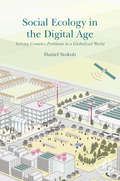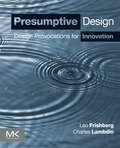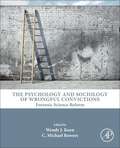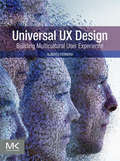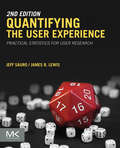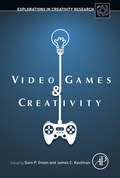- Table View
- List View
Encouraging Pro-Environmental Behaviour: What Works, What Doesn't, and Why
by Wokje AbrahamseEncouraging Pro-Environmental Behavior: What Works, What Doesn't, and Why examines the main drivers of human behavior related to environmental sustainability and how we can encourage environmental behavior change in humans. The book explores the underlying barriers and enablers of environmental behavior and outlines key theoretical advances from psychology to improve understanding. It then uses theory-based research in the development of behavior change interventions to critically evaluate empirical evidence on the effectiveness of those interventions. This book will help inform and improve the success of behavior change initiatives to mitigate climate change. Explores what influences behavior: who conserves and whyIncludes both theory and practiceFocuses on water and energy use, food choice and travel behaviorIdentifies impacts of incentives and interventions
Religion and Mental Health: Research and Clinical Applications
by Harold G. KoenigReligion and Mental Health: Research and Clinical Applications summarizes research on how religion may help people better cope or exacerbate their stress, covering its relationship to depression, anxiety, suicide, substance abuse, well-being, happiness, life satisfaction, optimism, generosity, gratitude and meaning and purpose in life. The book looks across religions and specific faiths, as well as to spirituality for those who don’t ascribe to a specific religion. It integrates research findings with best practices for treating mental health disorders for religious clients, also covering religious beliefs and practices as part of therapy to treat depression and posttraumatic stress disorder. Summarizes research findings on the relationship of religion to mental healthInvestigates religion’s positive and negative influence on copingPresents common findings across religions and specific faithsIdentifies how these findings inform clinical practice interventionsDescribes how to use religious practices and beliefs as part of therapy
Handbook of Investors' Behavior during Financial Crises
by Greg N. Gregoriou Vasileios Kallinterakis Fotini Economou Konstantinos GavriilidisThe Handbook of Investors' Behavior during Financial Crises provides fundamental information about investor behavior during turbulent periods, such the 2000 dot com crash and the 2008 global financial crisis. Contributors share the same behavioral finance tools and techniques while analyzing behaviors across a variety of market structures and asset classes. The volume provides novel insights about the influence and effects of regional differences in market design. Its distinctive approach to studies of financial crises is of key importance in our contemporary financial landscape, even more so since the accelerated process of globalization has rendered the outbreak of financial crises internationally more commonplace compared to previous decades.Encompasses empirical, quantitative and regulation-motivated studiesIncludes information about retail and institutional investor behaviorAnalyzes optimal financial structures for the development and growth of specific regional economies
The General Factor of Personality
by Janek MusekThe General Factor of Personality improves our understanding of the personality structure and the relations between major personality dimensions, as well as major dimensions of the entire non-cognitive sphere of psychological variables. The results of the empirical testing and theoretical evaluations in this book contribute to the more comprehensive and precise theoretical framework of the General Factor of Personality (GFP) and that of the entire personality structure. Additionally, the book answers some unresolved questions concerning the nature of the GFP, including whether it is based more on correlations in real behavior or on other less substantial factors between lower-order dimensions of personality. This book is crucially important not only for theoretical reasons, but also for the tremendous practical and applied value of the assumed general dimension of personality. As a common denominator of all the most important fields of personality beyond cognition (Big Five, well-being, coping, emotionality, motivation, self-concept, self-esteem, control, wisdom and others), the GFP represents an extremely strong single predictor of the quality of life, mental health and well-being, career, academic success, and the quality of family and interpersonal relations.Reviews the theoretical and methodological work on the General Factor of Personality (GFP)Presents major research results in the field of GFP and the dimensional structure of personalityProvides a balanced and objective approach to the topic of GFP, addressing criticisms and controversiesConsiders the practical and applied aspects of this researchDraws conclusions on the bioevolutionary model of GFP to give a more thorough understanding of biological bases of human personality
The Creative Self: Effect of Beliefs, Self-Efficacy, Mindset, and Identity (Explorations in Creativity Research)
by James C. Kaufman Maciej KarwowskiThe Creative Self reviews and summarizes key theories, studies, and new ideas about the role and significance self-beliefs play in one’s creativity. It untangles the interrelated constructs of creative self-efficacy, creative metacognition, creative identity, and creative self-concept. It explores how and when creative self-beliefs are formed as well as how creative self-beliefs can be strengthened. Part I discusses how creativity plays a part in one’s self-identity and its relationship with free will and efficacy. Part II discusses creativity present in day-to-day life across the lifespan. Part III highlights the intersection of the creative self with other variables such as mindset, domains, the brain, and individual differences. Part IV explores methodology and culture in relation to creativity. Part V, discusses additional constructs or theories that offer promise for future research on creativityExplores how beliefs about one’s creativity are part of one’s identityInvestigates the development of self-beliefs about creativityIdentifies external and personality factors influencing self-beliefs about creativityIncorporates worldwide research with cross-disciplinary contributors
Individual Differences and Personality
by Michael C. AshtonIndividual Differences and Personality, Third Edition provides a comprehensive overview of research on personality. The book begins with the main approaches to the study of personality, basic principles of personality measurement, the concept of personality traits, and the major dimensions of personality variation. Further chapters review personality change and stability, biological causal mechanisms, genetic and environmental influences and evolutionary adaptive function. Personality disorders are examined as are life outcomes—such as relationships, work, health, and others—that are predicted by personality characteristics. The book additionally examines important individual differences, such as mental abilities, vocational interests, religious beliefs, political attitudes and sexuality. The third edition is updated with new findings on age-related differences in personality, on sexual orientation and personality, on socially desirable responding in personality assessment, and on the biological and social origins of mental ability differences. Treatments of several topics have been streamlined, including reliability and validity, developmental change, genetic and environmental influences and the structure of mental abilities. Organized by issues in personality research rather than by theoristsIdentifies main traits in personality and explains personality assessmentExamines the impact of personality on life outcomesExplores developmental, genetic and evolutionary aspects of personalityIncludes other psychological characteristics (abilities, interests, beliefs and attitudes)Test bank included on the instructor website
Explaining Suicide: Patterns, Motivations, and What Notes Reveal
by Betty Yung Cheryl L. Meyer Taronish Irani Katherine A. HermesThe rate of suicides is at its highest level in nearly 30 years. Suicide notes have long been thought to be valuable resources for understanding suicide motivation, but up to now the small sample sizes available have made an in-depth analysis difficult. Explaining Suicide: Patterns, Motivations, and What Notes Reveal represents a large-scale analysis of suicide motivation across multiple ages during the same time period. This was made possible via a unique dataset of all suicide notes collected by the coroner’s office in southwestern Ohio 2000–2009. Based on an analysis of this dataset, the book identifies top motivations for suicide, how these differ between note writers and non-note writers, and what this can tell us about better suicide prevention. The book reveals the extent to which suicide is motivated by interpersonal violence, substance abuse, physical pain, grief, feelings of failure, and mental illness. Additionally, it discusses other risk factors, what differentiates suicide attempters from suicide completers, and lastly what might serve as protective factors toward resilience.Analyzes 1200+ suicide cases from one coroner’s officeIdentifies the top motivations for suicide that are based on suicide notesDiscusses the extent to which suicides are impulsive vs. plannedLeads to a better understanding on how to prevent suicideEmphasizes resilience factors over risk factors
Research Methods in Human-Computer Interaction
by Jonathan Lazar Harry Hochheiser Jinjuan Heidi FengResearch Methods in Human-Computer Interaction is a comprehensive guide to performing research and is essential reading for both quantitative and qualitative methods. Since the first edition was published in 2009, the book has been adopted for use at leading universities around the world, including Harvard University, Carnegie-Mellon University, the University of Washington, the University of Toronto, HiOA (Norway), KTH (Sweden), Tel Aviv University (Israel), and many others. Chapters cover a broad range of topics relevant to the collection and analysis of HCI data, going beyond experimental design and surveys, to cover ethnography, diaries, physiological measurements, case studies, crowdsourcing, and other essential elements in the well-informed HCI researcher's toolkit. Continual technological evolution has led to an explosion of new techniques and a need for this updated 2nd edition, to reflect the most recent research in the field and newer trends in research methodology. This Research Methods in HCI revision contains updates throughout, including more detail on statistical tests, coding qualitative data, and data collection via mobile devices and sensors. Other new material covers performing research with children, older adults, and people with cognitive impairments.Comprehensive and updated guide to the latest research methodologies and approaches, and now available in EPUB3 format (choose any of the ePub or Mobi formats after purchase of the eBook)Expanded discussions of online datasets, crowdsourcing, statistical tests, coding qualitative data, laws and regulations relating to the use of human participants, and data collection via mobile devices and sensorsNew material on performing research with children, older adults, and people with cognitive impairments, two new case studies from Google and Yahoo!, and techniques for expanding the influence of your research to reach non-researcher audiences, including software developers and policymakers
Sexual Assault Risk Reduction and Resistance: Theory, Research, and Practice
by Lindsay M. Orchowski Christine A. GidyczSexual Assault Risk Reduction and Resistance explores the theory, research, and practice of sexual assault risk reduction, resistance education, and self-defense programs for women and other vulnerable groups, including sexual minorities, individuals with disabilities, and those with histories of victimization. Following an ecosystemic perspective, the book examines individual risk and protective factors for sexual victimization, as well as peer-, family-, community- and societal-level factors that influence risk for sexual violence and inform the content of programs. This volume brings together leading researchers and practitioners to operationalize sexual assault risk reduction approaches and highlights the rationale and need for risk reduction in the context of other sexual assault prevention efforts. The volume provides an overview of the history of this sexual assault prevention approach and addresses current controversies and questions in the field. The authors outline risk and protective factors for victimization and discuss how these factors guide risk reduction efforts. The volume also outlines the theory and effectiveness of current sexual assault risk reduction and resistance practices and addresses special populations and future directions.Reviews theoretical approaches to sexual assault risk reduction Summarizes program outcome studies Delineates feminist self-defense approachesDetails what it means for prevention to be "trauma informed"Considers how to provide risk reduction without victim-blamingConfronts current controversies in the field of sexual assault risk reductionDetails how prevention can address the role of alcohol in sexual violenceDiscusses international prevention efforts
Handbook of Social Status Correlates
by Lee Ellis Anthony W. Hoskin Malini RatnasingamThe Handbook of Social Status Correlates summarizes findings from nearly 4000 studies on traits associated with variations in socioeconomic status. Much of the information is presented in roughly 300 tables, each one providing a visual snapshot of what research has indicated regarding how a specific human trait appears to be correlated with socioeconomic status. The social status measures utilized and the countries in which each study was conducted are also identified. QUESTIONS ADDRESSED INCLUDE THE FOLOWING: Are personality traits such as extraversion, competitiveness, and risk-taking associated with social status?How universal are sex differences in income and other forms of social status?What is the association between health and social status?How much does the answer vary according to specific diseases?How well established are the relationships between intelligence and social status?Is religiosity associated with social status, or does the answer depend on which religion is being considered?Are physiological factors correlated with social status, even factors involving the brain?Finally, are there as yet any "universal correlates of social status"?
Personality and Disease: Scientific Proof vs. Wishful Thinking
by Christoffer JohansenA tremendous amount of research has been performed looking at the relationship between personality and disease. Research on this topic has been spread throughout scientific journals on psychology, behavioral health, psychoneuroimmunology, oncology, and epidemiology. Personality and Disease brings this research together in one place for the first time. With contributions from world experts, the book summarizes research findings on personality as it relates to cancer, heart disease, diabetes, asthma and allergies, dementia, and more. Is there such a thing as a cancer- prone personality? Do sadness, anger, stress, or shyness affect the likelihood that we will fall ill to specific diseases? Can we protect ourselves from disease through a positive outlook? This book will address both what we know, and what we persist in believing despite evidence to the contrary, and why such beliefs persist in the face of evidence.Investigates whether and how personality affects disease generallyIncludes cancer, heart disease, diabetes, asthma, allergies, and dementiaSeparates fact from fiction, evidence from beliefsCollates research from a wide variety of scientific domainsContains international perspectives from top scholars
Designing User Interfaces for an Aging Population: Towards Universal Design
by Jeff Johnson Kate FinnDesigning User Interfaces for an Aging Population: Towards Universal Design presents age-friendly design guidelines that are well-established, agreed-upon, research-based, actionable, and applicable across a variety of modern technology platforms. The book offers guidance for product engineers, designers, or students who want to produce technological products and online services that can be easily and successfully used by older adults and other populations. It presents typical age-related characteristics, addressing vision and visual design, hand-eye coordination and ergonomics, hearing and sound, speech and comprehension, navigation, focus, cognition, attention, learning, memory, content and writing, attitude and affect, and general accessibility. The authors explore characteristics of aging via realistic personas which demonstrate the impact of design decisions on actual users over age 55.Presents the characteristics of older adults that can hinder use of technologyProvides guidelines for designing technology that can be used by older adults and younger peopleReview real-world examples of designs that implement the guidelines and the designs that violate them
Handbook of Crime Correlates
by David P. Farrington Lee Ellis Anthony W. HoskinThe Handbook of Crime Correlates, Second Edition summarizes more than a century of worldwide research on traits and social conditions associated with criminality and antisocial behavior. Findings are provided in tabular form, enabling readers to determine at a glance the nature of each association. Within each table, results are listed by country, type of crime (or other forms of antisocial behavior), and whether each variable is positively, negatively, or insignificantly associated with offending behavior. Criminal behavior is broken down according to major categories, including violent crime, property crime, drug offenses, sex offenses, delinquency, and recidivism. This book provides a resource for practitioners and academics who are interested in criminal and antisocial behavior. It is relevant to the fields of criminology/criminal justice, sociology, and psychology. No other publication provides as much information about how a wide range of variables—e.g., gender, religion, personality traits, weapons access, alcohol and drug use, social status, geography, and seasonality—correlate with offending behavior.Includes 600+ tables regarding variables related to criminal behaviorConsolidates 100+ years of academic research on criminal behaviorFindings are identified by country and world regions for easy comparisonLists criminal-related behaviors according to major categoriesIdentifies universal crime correlates
Usability Testing for Survey Research
by Emily Geisen Jennifer Romano BergstromUsability Testing for Survey Research provides researchers with a guide to the tools necessary to evaluate, test, and modify surveys in an iterative method during the survey pretesting process. It includes examples that apply usability to any type of survey during any stage of development, along with tactics on how to tailor usability testing to meet budget and scheduling constraints. The book's authors distill their experience to provide tips on how usability testing can be applied to paper surveys, mixed-mode surveys, interviewer-administered tools, and additional products. Readers will gain an understanding of usability and usability testing and why it is needed for survey research, along with guidance on how to design and conduct usability tests, analyze and report findings, ideas for how to tailor usability testing to meet budget and schedule constraints, and new knowledge on how to apply usability testing to other survey-related products, such as project websites and interviewer administered tools.Explains how to design and conduct usability tests and analyze and report the findingsIncludes examples on how to conduct usability testing on any type of survey, from a simple three-question survey on a mobile device, to a complex, multi-page establishment surveyPresents real-world examples from leading usability and survey professionals, including a diverse collection of case studies and considerations for using and combining other methodsDiscusses the facilities, materials, and software needed for usability testing, including in-lab testing, remote testing, and eye tracking
Social Ecology in the Digital Age: Solving Complex Problems in a Globalized World
by Daniel StokolsSocial Ecology in the Digital Age: Solving Complex Problems in a Globalized World provides a comprehensive overview of social ecological theory, research, and practice. Written by renowned expert Daniel Stokols, the book distills key principles from diverse strands of ecological science, offering a robust framework for transdisciplinary research and societal problem-solving. The existential challenges of the 21st Century - global climate change and climate-change denial, environmental pollution, biodiversity loss, food insecurity, disease pandemics, inter-ethnic violence and the threat of nuclear war, cybercrime, the Digital Divide, and extreme poverty and income inequality confronting billions each day - cannot be understood and managed adequately from narrow disciplinary or political perspectives. Social Ecology in the Digital Age is grounded in scientific research but written in a personal and informal style from the vantage point of a former student, current teacher and scholar who has contributed over four decades to the field of social ecology. The book will be of interest to scholars, students, educators, government leaders and community practitioners working in several fields including social and human ecology, psychology, sociology, anthropology, criminology, law, education, biology, medicine, public health, earth system and sustainability science, geography, environmental design, urban planning, informatics, public policy and global governance. Winner of the 2018 Gerald L. Young Book Award from The Society for Human Ecology "Exemplifying the highest standards of scholarly work in the field of human ecology." https://societyforhumanecology.org/human-ecology-homepage/awards/gerald-l-young-book-award-in-human-ecology/The book traces historical origins and conceptual foundations of biological, human, and social ecologyOffers a new conceptual framework that brings together earlier approaches to social ecology and extends them in novel directionsHighlights the interrelations between four distinct but closely intertwined spheres of human environments: our natural, built, sociocultural, and virtual (cyber-based) surroundingsSpans local to global scales and individual, organizational, community, regional, and global levels of analysisApplies core principles of social ecology to identify multi-level strategies for promoting personal and public health, resolving complex social problems, managing global environmental change, and creating resilient and sustainable communitiesUnderscores social ecology’s vital importance for understanding and managing the environmental and political upheavals of the 21st CenturyHighlights descriptive, analytic, and transformative (or moral) concerns of social ecology Presents strategies for educating the next generation of social ecologists emphasizing transdisciplinary, team-based, translational, and transcultural approaches
Presumptive Design: Design Provocations for Innovation
by Leo Frishberg Charles LambdinEverything you know about the future is wrong. Presumptive Design: Design Provocations for Innovation is for people “inventing" the future: future products, services, companies, strategies and policies. It introduces a design-research method that shortens time to insights from months to days. Presumptive Design is a fundamentally agile approach to identifying your audiences’ key needs. Offering rapidly crafted artifacts, your teams collaborate with your customers to identify preferred and profitable elements of your desired outcome. Presumptive Design focuses on your users’ problem space, informing your business strategy, your project’s early stage definition, and your innovation pipeline. Comprising discussions of design theory with case studies and how-to’s, the book offers business leadership, management and innovators the benefits of design thinking and user experience in the context of early stage problem definition. Presumptive Design is an advanced technique and quick to use: within days of reading this book, your research and design teams can apply the approach to capture a risk-reduced view of your future.Provides actionable approaches to inform strategy and problem definition through design thinkingOffers a design-based research method to complement existing market, ethnographic and customer research methodsDemonstrates a powerful technique for identifying disruptive innovation early in the innovation pipeline by putting customers firstPresents each concept with case studies and exploration of risk factors involved including warnings for situations in which the technique can be misapplied
Multiscreen UX Design: Developing for a Multitude of Devices
by Wolfram NagelPeople today use technology on different devices in different locations. Users expect to access information on all relevant screens and across multiple channels through smartphones, tablets, laptops/desktops, smart (internet-connected) TVs, and other devices, such as smartwatches for example. Multiscreen is no longer a nice add-on, it’s a requirement. In this environment, user experience needs to cater to multiple devices. This book provides a holistic approach that will help UX professionals to offer a hands-on guide for UX design across multiple screens. It presents an opportunity to learn how to cater designs for customers. Readers will find patterns, strategies, examples and case studies, methodologies, and insights to help inspire them to develop a viable strategy for their own digital products and services. UX professionals will walk through important elements of multiscreen UX: Investigating the devices and their capabilitiesUnderstanding the users and their capabilitiesConsidering the context in which users use these devicesNavigating next generation information experiences and the future of content management Designing content and UI architecture for multiscreen projectsA hands-on, practical guide to UX design for how users approach content – across more than one screen at a timeDiscusses devices, users, and their practicesIncludes best practices, real-world examples, and tips and tricksA preface written by Scott Jenson
The Psychology and Sociology of Wrongful Convictions: Forensic Science Reform (PDF)
by Edited by Wendy J. Koen C. Michael BowersWrongful convictions are the result of faulty or false scientific evidence in 50% of the cases. Defense counsel is often at a great disadvantage in defending against evidence based on science. Illusory Evidence: The Psychology and Sociology of Wrongful Convictions is written for the non-scientist, to make complicated scientific information clear and concise enough for attorneys and judges to master. This is obtained by providing case studies to simplify issues in forensic psychology for the legal professional: Increases the courts’ knowledge about areas of psychology that have been debunked, have advanced, or have been refined by the scientific community; Covers issues in psychological forensics, namely: Profiling, Psychological Defenses, Mitigation, Eyewitness Testimony/Identification, Child Testimony, Repressed Memories, False Confessions and Moral Panic; Trains prosecuting attorneys about the present state of the forensic psychology, to avoid relying only on legal precedent and will not present flawed science to the court; Provides defense attorneys the knowledge necessary to competently defend where forensic psychology plays a part in a prosecution; Arms innocence projects and appellate attorneys with the latest information to challenge convictions; Uses case studies to simplify issues in forensic psychology for the legal professional.
Universal UX Design: Building Multicultural User Experience
by Alberto FerreiraUniversal UX Design: Building Multicultural User Experience provides an ideal guide as multicultural UX continues to emerge as a transdisciplinary field that, in addition to the traditional UI and corporate strategy concerns, includes socio/cultural and neurocognitive concerns that constitute one of the first steps in a truly global product strategy. In short, multicultural UX is no longer a nice-to-have in your overall UX strategy, it is now a must-have. This practical guide teaches readers about international concerns on the development of a uniquely branded, yet culturally appealing, software end-product. With hands-on examples throughout, readers will learn how to accurately predict user behavior, optimize layout and text elements, and integrate persuasive design in layout, as well as how to determine which strategies to communicate image and content more effectively, while demystifying the psychological and sociopolitical factors associated with culture. The book reviews the essentials of cognitive UI perception and how they are affected by socio-cultural conditioning, as well as how different cultural bias and expectations can work in UX design.Teaches how to optimize design using internationalization techniquesExplores how to develop web and mobile internationalization frameworksPresents strategies for effectively reaching a multicultural audienceReviews the essentials of cognitive UI perception and the related effects of socio-cultural conditioning, as well as how different cultural bias and expectations can work in UX design
Quantifying the User Experience: Practical Statistics for User Research
by James R Lewis Jeff SauroQuantifying the User Experience: Practical Statistics for User Research, Second Edition, provides practitioners and researchers with the information they need to confidently quantify, qualify, and justify their data. The book presents a practical guide on how to use statistics to solve common quantitative problems that arise in user research. It addresses questions users face every day, including, Is the current product more usable than our competition? Can we be sure at least 70% of users can complete the task on their first attempt? How long will it take users to purchase products on the website? This book provides a foundation for statistical theories and the best practices needed to apply them. The authors draw on decades of statistical literature from human factors, industrial engineering, and psychology, as well as their own published research, providing both concrete solutions (Excel formulas and links to their own web-calculators), along with an engaging discussion on the statistical reasons why tests work and how to effectively communicate results. Throughout this new edition, users will find updates on standardized usability questionnaires, a new chapter on general linear modeling (correlation, regression, and analysis of variance), with updated examples and case studies throughout.Completely updated to provide practical guidance on solving usability testing problems with statistics for any project, including those using Six Sigma practicesIncludes new and revised information on standardized usability questionnairesIncludes a completely new chapter introducing correlation, regression, and analysis of varianceShows practitioners which test to use, why they work, and best practices for application, along with easy-to-use Excel formulas and web-calculators for analyzing dataRecommends ways for researchers and practitioners to communicate results to stakeholders in plain English
Emotions, Technology, and Social Media (ISSN)
by Sharon TettegahEmotions, Technology, and Social Media discusses the ways the social media sphere uses emotion and technology, and how each of these has become part of the digital culture. The book explores this expression within a psychological theoretical framework, addressing feelings about social media, and its role in education and knowledge generation. The second section investigates the expression of feelings within social media spaces, while subsequent sections adopt a paradigm of active audience consumption to use social media to express feelings and maintain social connectivity.Discusses the significant relationships between Web 2.0 technologies and learning traitsPresents studies about Facebook usage and individual emotional statesInvestigates the shared emotions in the construction of “cyberculture"Shows the extent to which scientists use social media in their work, and the ways in which they use the social mediaAnalyzes the consequences of the online disinhibition effectExamines YouTube as a source of opinions and discussions which can be used to track the emotions evoked by videos and the emotions expressed through textual comments Details how Reddit users’ media choices are emotionally useful and gratifying in the “memeplex"Links social interaction and the emotional life with that of digital devices and resources
Emotions and Affect in Human Factors and Human-Computer Interaction
by Myounghoon JeonEmotions and Affect in Human Factors and Human–Computer Interaction is a complete guide for conducting affect-related research and design projects in H/F and HCI domains. Introducing necessary concepts, methods, approaches, and applications, the book highlights how critical emotions and affect are to everyday life and interaction with cognitive artifacts. The text covers the basis of neural mechanisms of affective phenomena, as well as representative approaches to Affective Computing, Kansei Engineering, Hedonomics, and Emotional Design. The methodologies section includes affect induction techniques, measurement techniques, detection and recognition techniques, and regulation models and strategies. The application chapters discuss various H/F and HCI domains: product design, human–robot interaction, behavioral health and game design, and transportation. Engineers and designers can learn and apply psychological theories and mechanisms to account for their affect-related research and can develop their own domain-specific theory. The approach outlined in this handbook works to close the existing gap between the traditional affect research and the emerging field of affective design and affective computing.Provides a theoretical background of affective sciencesDemonstrates diverse affect induction methods in actual research settingsDescribes sensing technologies, such as brain–computer interfaces, facial expression detection, and moreCovers emotion modeling and its application to regulation processesIncludes case studies and applied examples in a variety of H/F and HCI application areasAddresses emerging interdisciplinary areas including Positive Technology, Subliminal Perception, Physiological Computing, and Aesthetic Computing
Emotions, Technology, and Digital Games (ISSN)
by Sharon Tettegah Wenhao David HuangEmotions, Technology, and Digital Games explores the need for people to experience enjoyment, excitement, anxiety, anger, frustration, and many other emotions. The book provides essential information on why it is necessary to have a greater understanding of the power these emotions have on players, and how they affect players during, and after, a game. This book takes this understanding and shows how it can be used in practical ways, including the design of video games for teaching and learning, creating tools to measure social and emotional development of children, determining how empathy-related thought processes affect ethical decision-making, and examining how the fictional world of game play can influence and shape real-life experiences. Details how games affect emotions—both during and after playDescribes how we can manage a player’s affective reactionsApplies the emotional affect to making games more immersiveExamines game-based learning and educationIdentifies which components of online games support socio-emotional developmentDiscusses the impact of game-based emotions beyond the context of games
Emotions, Technology, and Health (ISSN)
by Sharon Tettegah Yolanda E GarciaEmotions, Technology, and Health examines how healthcare consumers interact with health technology, how this technology mediates interpersonal interactions, and the effectiveness of technology in gathering health-related information in various situations. The first section discusses the use of technology to monitor patients’ emotional responses to illness and its treatment, as well as the role of technology in meeting the fundamental human need for information. Section Two describes the use of technology in mediating emotions within and between individuals, and addresses the implications for the design and use of devices that gather behavioral health data and contribute to healthcare interventions. The final section assesses different situations in which technology is a key component of the health intervention—such as tablet use in educating elementary school students with social skills difficulty, physical activity monitoring for children at risk for obesity, and teleconferencing for older adults at risk of social isolation. Shows how information on the internet significantly affects the medical decision-making process for many consumersDescribes current applications of social computing and quick access to mental health information on portable electronic devicesDiscusses how cyber-communication may both impair and enhance one’s sense of humanityDetails the role of visual media in mediating emotion and memory of time
Video Games and Creativity (Explorations in Creativity Research)
by James C. Kaufman Garo GreenVideo games have become an increasingly ubiquitous part of society due to the proliferation and use of mobile devices. Video Games and Creativity explores research on the relationship between video games and creativity with regard to play, learning, and game design. It answers such questions as: Can video games be used to develop or enhance creativity?Is there a place for video games in the classroom?What types of creativity are needed to develop video games? While video games can be sources of entertainment, the role of video games in the classroom has emerged as an important component of improving the education system. The research and development of game-based learning has revealed the power of using games to teach and promote learning. In parallel, the role and importance of creativity in everyday life has been identified as a requisite skill for success.Summarizes research relating to creativity and video gamesIncorporates creativity research on both game design and game playDiscusses physical design, game mechanics, coding, and moreInvestigates how video games may encourage creative problem solvingHighlights applications of video games for educational purposes














